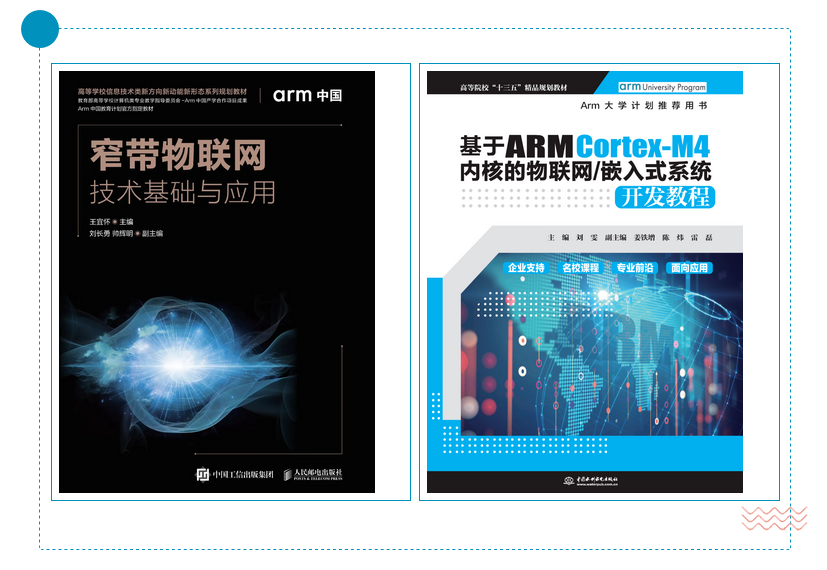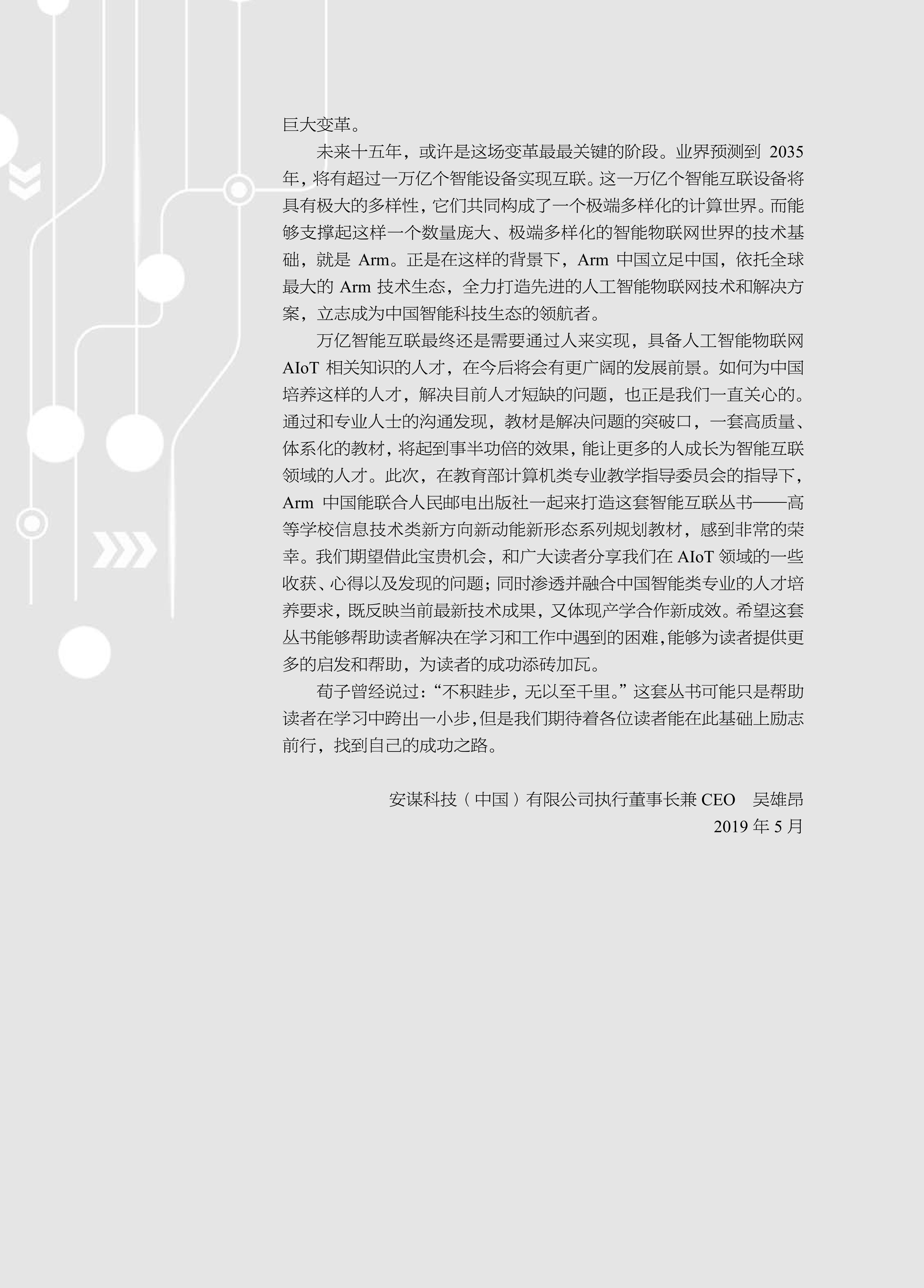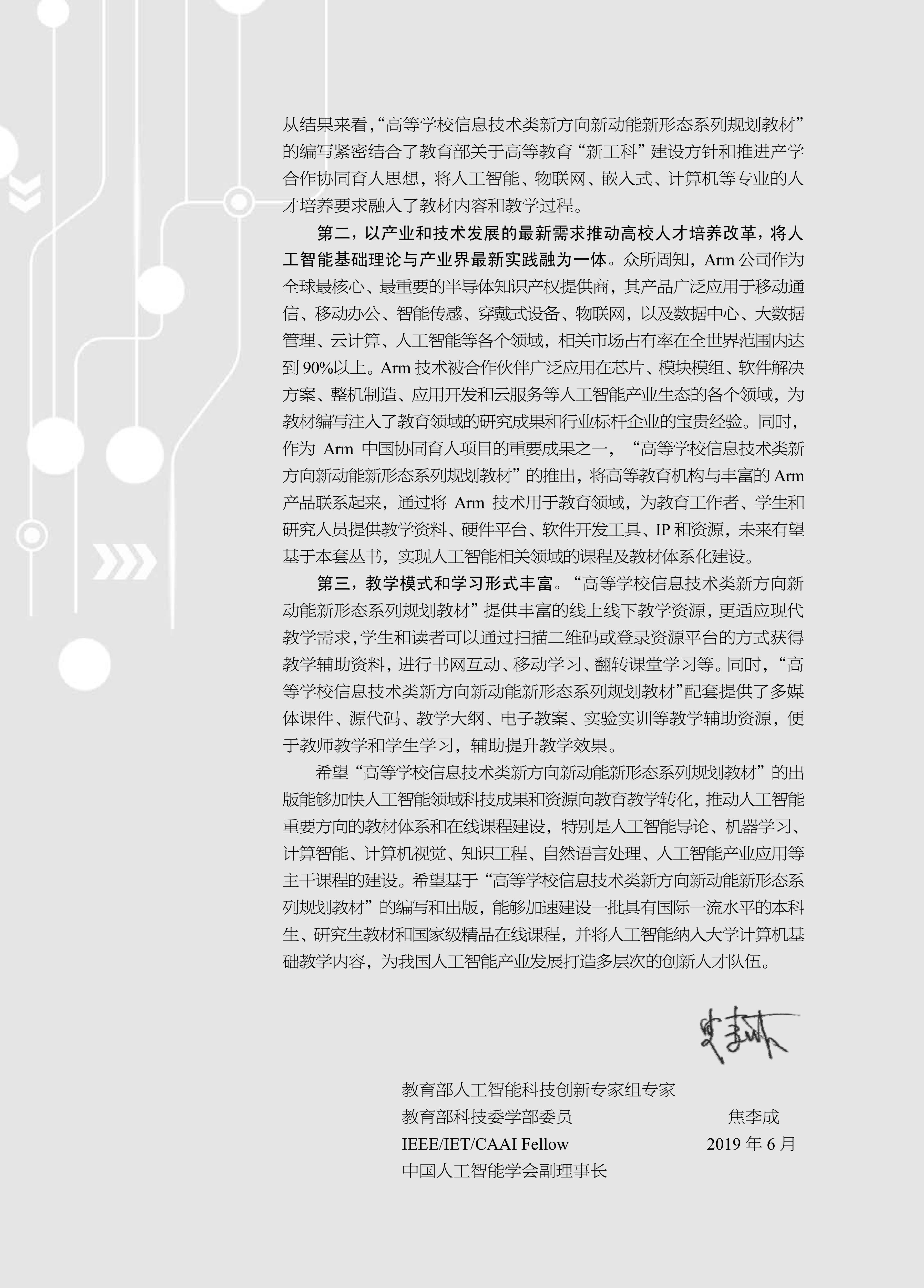2020年中秋和国庆“喜相逢”,
双节同庆,先祝大家合家团圆,
祝祖国繁荣昌盛!
千盼万盼的十一长假都要来了~
小伙伴们心心念念的赠书活动还会远吗?
本次小编为大家准备了2本物联网技术的好书,
任你选喔,你懂的
活动介绍
**活动时间
9月29日-10月9日上午8点**1.参与方式:点击此链接报名参加,提交报名信息即可。我们将随机抽取30位小伙伴免费送出《窄带物联网基础与应用》或《基于Arm Cortex-M4内核的物联网/嵌入式系统开发教程》一本,欢迎参加~
2.样章试读:微信关注“Arm中国学堂”, 后台回复“0929” 获取2本书的第1-2章样章试读!
3.如何购买:
《窄带物联网基础与应用》
(高校教师可免费申请此样书)
https://www.ryjiaoyu.com/book/details/9205
《基于Arm Cortex-M4内核的物联网/嵌入式系统开发教程》
https://item.jd.com/12310983.html4.温馨提示:活动结束后,我们将在极术社区发布中奖通知并发送邮件给您,工作人员会尽快为您快递教材!
感谢公众号:Mculover666、公众号:嵌入式客栈、人民邮电出版社、水利水电出版社对本次极术赠书活动的大力支持!
优质公号推荐
Mculover666
嵌入式客栈
《窄带物联网基础与应用》教材介绍
内容简介
本书把窄带物联网(NB-IoT)的应用知识体系归纳为终端、信息邮局、人机交互系统 3 个有机组成部分。
针对终端,给出通用嵌入式计算机的概念,并将其软件分为 BIOS 与 User 两部分;
针对信息邮局, 将其抽象为固定 IP 地址与端口,并由此设计了云侦听程序模板;
针对人机交互系统,设计了 Web 网页、 微信小程序、手机 App 及 PC 客户端等模板。
本书形成了以通用嵌入式计算机为核心、以构件为支撑、以工程模板为基础的 NB-IoT应用开发生态系统,构成了 NB-IoT 技术基础与应用知识体系,可有效降低 读者的学习与应用门槛。
本书可作为高等院校物联网工程专业相关课程的教材,也可作为物联网工程相关领域学者学习的参考用书,还可作为 NB-IoT 应用技术的培训用书。
作者简介
<span class="colour" style="color:rgb(33, 37, 41)">王宜怀,博士,苏州大学计算机科学与技术学院教授、博士生导师、网络工程系主任;苏州大学嵌入式系统与物联网研究所所长;苏州市政协常委;江苏省计算机学会嵌入式系统与物联网专业委员会主任、中国软件行业协会嵌入式系统分会理事。</span>
<span class="colour" style="color:rgb(33, 37, 41)">从1990年开始至今一直致力于嵌入式系统与物联网等研发与教学工作。完成国家自然科学基金3项,省级科研项目6项。完成《基于传感网技术的城市照明控制系统》、《图形构件化嵌入式与传感网开发平台》、《金葫芦IoT-GEC》等30余项应用开发类科研项目。撰写《嵌入式技术基础与实践》、《汽车电子KEA系列微控制器》等10余部著作。获得发明专利12项,公开发表论文80余篇。</span>
<span class="colour" style="color:rgb(33, 37, 41)">主要研究方向:嵌入式系统、物联网与智能控制技术。</span>
本书特色
提取共性技术,降低学习门槛。
在具备NB-IoTa网络的前提下,本书面向物联网实际应用,给出了NB-IoT终端、云侦听、网页、微信小程序、手机APP等应用模板,为“照葫芦画瓢”地进行物联网应用开发提供了共性技术,直接进行上行、下行通信过程,可以有效降低学习与开发门槛。
应用模板丰富,学习过程轻松。
本书不仅给了NB-IoT终端、云侦听、网页、微信小程序、手机APP等应用模块,还给出了4G/5G、WIFI、WSN等应用模块,可以助力读者快速上手并轻松实现物联。
代码注释细致,配套资源齐全。
本书纸质书稿与电子资源中所提供的源程序框架合理、逻辑清晰,且给出了详细的注释,可以帮助读者细致理解各部分代码的作用;此外。本书还提供了诸如课程PPT、视频索引、常用软件工具、教学指导方案等配套资源,可以极大程度地提升“教与学”的效果。
<span class="colour" style="color:rgb(51, 51, 51)">微信小程序提供直观学习体验。</span>
<span class="colour" style="color:rgb(51, 51, 51)">本书编者团队已配套推出“窄带物联网教材”微信小程序,读者可通过手机微信端搜索该小程序并直观体验窄带物联网应用开发的相关知识与技术。</span>
目录一览
<span class="colour" style="color:rgb(17, 17, 17)">第1章 NB-IoT概述与直观体验 1</span>
<span class="colour" style="color:rgb(17, 17, 17)">1.1 NB-IoT简介 1</span>
<span class="colour" style="color:rgb(17, 17, 17)">1.1.1 物联网无线通信连接方式的分类 2</span>
<span class="colour" style="color:rgb(17, 17, 17)">1.1.2 NB-IoT简明发展历程与技术特点 2</span>
<span class="colour" style="color:rgb(17, 17, 17)">1.1.3 为什么NB-IoT将会流行 4</span>
<span class="colour" style="color:rgb(17, 17, 17)">1.2 NB-IoT技术与其他LPWAN技术比较 5</span>
<span class="colour" style="color:rgb(17, 17, 17)">1.3 降低NB-IoT应用技术学习门槛的基本思路 6</span>
<span class="colour" style="color:rgb(17, 17, 17)">1.3.1 NB-IoT应用开发所面临的难题 7</span>
<span class="colour" style="color:rgb(17, 17, 17)">1.3.2 解决NB-IoT应用开发所面临难题的基本思路 7</span>
<span class="colour" style="color:rgb(17, 17, 17)">1.4 直观体验NB-IoT数据传输 7</span>
<span class="colour" style="color:rgb(17, 17, 17)">1.4.1 通过微信小程序方式的直观体验 8</span>
<span class="colour" style="color:rgb(17, 17, 17)">1.4.2 通过网页浏览器方式的直观体验 8</span>
<span class="colour" style="color:rgb(17, 17, 17)">1.4.3 通过Android手机App方式的直观体验 9</span>
<span class="colour" style="color:rgb(17, 17, 17)">1.4.4 通过运行客户端程序的直观体验 9</span>
<span class="colour" style="color:rgb(17, 17, 17)">1.5 实践平台—金葫芦NB-IoT开发套件简介 10</span>
<span class="colour" style="color:rgb(17, 17, 17)">1.5.1 金葫芦NB-IoT开发套件设计思想 10</span>
<span class="colour" style="color:rgb(17, 17, 17)">1.5.2 金葫芦NB-IoT开发套件硬件组成 11</span>
<span class="colour" style="color:rgb(17, 17, 17)">1.5.3 金葫芦NB-IoT开发套件软件资源 13</span>
<span class="colour" style="color:rgb(17, 17, 17)">1.5.4 AHL-GEC-IDE开发环境 13</span>
<span class="colour" style="color:rgb(17, 17, 17)">1.6 实验一 初识NB-IoT通信 14</span>
<span class="colour" style="color:rgb(17, 17, 17)">1.7 习题 15</span>
<span class="colour" style="color:rgb(17, 17, 17)">第2章 NB-IoT应用架构及通信基本过程 16</span>
<span class="colour" style="color:rgb(17, 17, 17)">2.1 建立NB-IoT应用架构的基本原则 16</span>
<span class="colour" style="color:rgb(17, 17, 17)">2.2 终端UE、信息邮局MPO与人机交互系统HCI的基本定义 16</span>
<span class="colour" style="color:rgb(17, 17, 17)">2.2.1 NB-IoT终端UE 17</span>
<span class="colour" style="color:rgb(17, 17, 17)">2.2.2 NB-IoT信息邮局MPO 17</span>
<span class="colour" style="color:rgb(17, 17, 17)">2.2.3 NB-IoT人机交互系统HCI 17</span>
<span class="colour" style="color:rgb(17, 17, 17)">2.3 NB-IoT通信过程与应用开发相关的基本概念 17</span>
<span class="colour" style="color:rgb(17, 17, 17)">2.3.1 与终端UE相关的基本概念 18</span>
<span class="colour" style="color:rgb(17, 17, 17)">2.3.2 与信息邮局MPO相关的基本概念 19</span>
<span class="colour" style="color:rgb(17, 17, 17)">2.3.3 与人机交互系统HCI相关的基本概念 21</span>
<span class="colour" style="color:rgb(17, 17, 17)">2.4 基于信息邮局初略了解基本通信过程 22</span>
<span class="colour" style="color:rgb(17, 17, 17)">2.5 实验二 了解信息邮局MPO的基本参数 23</span>
<span class="colour" style="color:rgb(17, 17, 17)">2.6 习题 24</span>
<span class="colour" style="color:rgb(17, 17, 17)">第3章 终端UE基础构件知识要素与实践 25</span>
<span class="colour" style="color:rgb(17, 17, 17)">3.1 终端UE的编程框架与三类构件 25</span>
<span class="colour" style="color:rgb(17, 17, 17)">3.2 GPIO、UART及Flash构件 25</span>
<span class="colour" style="color:rgb(17, 17, 17)">3.2.1 GPIO构件 25</span>
<span class="colour" style="color:rgb(17, 17, 17)">3.2.2 UART构件 34</span>
<span class="colour" style="color:rgb(17, 17, 17)">3.2.3 Flash构件 39</span>
<span class="colour" style="color:rgb(17, 17, 17)">3.3 ADC与PWM构件 42</span>
<span class="colour" style="color:rgb(17, 17, 17)">3.3.1 ADC构件 42</span>
<span class="colour" style="color:rgb(17, 17, 17)">3.3.2 PWM构件 46</span>
<span class="colour" style="color:rgb(17, 17, 17)">3.4 I2C与SPI构件 50</span>
<span class="colour" style="color:rgb(17, 17, 17)">3.4.1 I2C构件 50</span>
<span class="colour" style="color:rgb(17, 17, 17)">3.4.2 SPI构件 58</span>
<span class="colour" style="color:rgb(17, 17, 17)">3.5 实验三 理解构件的使用方法 64</span>
<span class="colour" style="color:rgb(17, 17, 17)">3.6 习题 66</span>
<span class="colour" style="color:rgb(17, 17, 17)">第4章 终端UE与云侦听程序的通信过程 67</span>
<span class="colour" style="color:rgb(17, 17, 17)">4.1 终端UE与云侦听模板工程功能简介 67</span>
<span class="colour" style="color:rgb(17, 17, 17)">4.1.1 终端UE模板工程的运行流程 67</span>
<span class="colour" style="color:rgb(17, 17, 17)">4.1.2 云侦听模板工程功能简介 67</span>
<span class="colour" style="color:rgb(17, 17, 17)">4.2 建立云侦听程序的运行场景 68</span>
<span class="colour" style="color:rgb(17, 17, 17)">4.2.1 FRP内网穿透基本原理 69</span>
<span class="colour" style="color:rgb(17, 17, 17)">4.2.2 利用苏大云服务器搭建读者的临时服务器 69</span>
<span class="colour" style="color:rgb(17, 17, 17)">4.3 运行云侦听与终端UE模板工程 72</span>
<span class="colour" style="color:rgb(17, 17, 17)">4.3.1 运行终端UE模板工程 72</span>
<span class="colour" style="color:rgb(17, 17, 17)">4.3.2 运行CS-Monitor模板工程 73</span>
<span class="colour" style="color:rgb(17, 17, 17)">4.3.3 通信过程中常见错误说明 75</span>
<span class="colour" style="color:rgb(17, 17, 17)">4.4 “照葫芦画瓢”设计自己的终端UE与云侦听程序 76</span>
<span class="colour" style="color:rgb(17, 17, 17)">4.4.1 “照葫芦画瓢”更改终端用户程序 76</span>
<span class="colour" style="color:rgb(17, 17, 17)">4.4.2 CS-Monitor程序的“照葫芦画瓢” 80</span>
<span class="colour" style="color:rgb(17, 17, 17)">4.4.3 联合测试 83</span>
<span class="colour" style="color:rgb(17, 17, 17)">4.5 实验四 终端UE与云侦听程序基本实践 84</span>
<span class="colour" style="color:rgb(17, 17, 17)">4.6 习题 85</span>
<span class="colour" style="color:rgb(17, 17, 17)">第5章 理解终端UE与云侦听程序 86</span>
<span class="colour" style="color:rgb(17, 17, 17)">5.1 终端UE程序框架解析与执行流程 86</span>
<span class="colour" style="color:rgb(17, 17, 17)">5.1.1 终端UE程序框架 86</span>
<span class="colour" style="color:rgb(17, 17, 17)">5.1.2 终端UE的主流程及中断处理程序 88</span>
<span class="colour" style="color:rgb(17, 17, 17)">5.2 理解终端UE与CS-Monitor通信构件UECom 91</span>
<span class="colour" style="color:rgb(17, 17, 17)">5.2.1 UECom构件的设计要点 91</span>
<span class="colour" style="color:rgb(17, 17, 17)">5.2.2 UECom构件头文件 92</span>
<span class="colour" style="color:rgb(17, 17, 17)">5.2.3 UECom构件的使用方法 97</span>
<span class="colour" style="color:rgb(17, 17, 17)">5.3 云侦听程序CS-Monitor框架解析与执行流程 99</span>
<span class="colour" style="color:rgb(17, 17, 17)">5.3.1 WebSocket协议与JSON格式 99</span>
<span class="colour" style="color:rgb(17, 17, 17)">5.3.2 CS-Monitor模板工程框架 100</span>
<span class="colour" style="color:rgb(17, 17, 17)">5.3.3 CS-Monitor模板自动执行流程 102</span>
<span class="colour" style="color:rgb(17, 17, 17)">5.3.4 NB-IoT应用架构的通信过程 110</span>
<span class="colour" style="color:rgb(17, 17, 17)">5.3.5 CS-Monitor模板按键事件的解析 115</span>
<span class="colour" style="color:rgb(17, 17, 17)">5.4 理解CS-Monitor中通信接口类HCICom 117</span>
<span class="colour" style="color:rgb(17, 17, 17)">5.4.1 HCICom类的设计要点 118</span>
<span class="colour" style="color:rgb(17, 17, 17)">5.4.2 HCICom类的属性、方法和事件 119</span>
<span class="colour" style="color:rgb(17, 17, 17)">5.4.3 HCICom类的使用方法 120</span>
<span class="colour" style="color:rgb(17, 17, 17)">5.5 理解数据入库过程 121</span>
<span class="colour" style="color:rgb(17, 17, 17)">5.5.1 查看数据库与表的简单方法 121</span>
<span class="colour" style="color:rgb(17, 17, 17)">5.5.2 各数据表的用途 122</span>
<span class="colour" style="color:rgb(17, 17, 17)">5.5.3 操作数据库的基本编程方法 123</span>
<span class="colour" style="color:rgb(17, 17, 17)">5.6 实验五 理解终端UE数据通过NB-IoT通信存入数据库 124</span>
<span class="colour" style="color:rgb(17, 17, 17)">5.7 习题 126</span>
<span class="colour" style="color:rgb(17, 17, 17)">第6章 通过Web网页的数据访问 127</span>
<span class="colour" style="color:rgb(17, 17, 17)">6.1 运行Web模板观察自己终端UE数据 127</span>
<span class="colour" style="color:rgb(17, 17, 17)">6.2 面向NB-IoT的Web网页设计 128</span>
<span class="colour" style="color:rgb(17, 17, 17)">6.2.1 NB-IoT的Web网页模板工程结构 128</span>
<span class="colour" style="color:rgb(17, 17, 17)">6.2.2 “照葫芦画瓢”设计自己的NB-IoT网页 129</span>
<span class="colour" style="color:rgb(17, 17, 17)">6.3 理解NB-IoT的Web网页模板 131</span>
<span class="colour" style="color:rgb(17, 17, 17)">6.3.1 NB-IoT的Web网页模板功能分析 132</span>
<span class="colour" style="color:rgb(17, 17, 17)">6.3.2 通过Web网页的数据访问过程 132</span>
<span class="colour" style="color:rgb(17, 17, 17)">6.3.3 NB-IoT的Web网页编程的进一步讨论 140</span>
<span class="colour" style="color:rgb(17, 17, 17)">6.4 实验六 终端UE数据实时到达Web网页 142</span>
<span class="colour" style="color:rgb(17, 17, 17)">6.5 习题 143</span>
<span class="colour" style="color:rgb(17, 17, 17)">第7章 通过微信小程序的数据访问 144</span>
<span class="colour" style="color:rgb(17, 17, 17)">7.1 运行小程序模板观察自己终端UE数据 144</span>
<span class="colour" style="color:rgb(17, 17, 17)">7.2 在开发环境中运行NB-IoT微信小程序 145</span>
<span class="colour" style="color:rgb(17, 17, 17)">7.2.1 前期准备 145</span>
<span class="colour" style="color:rgb(17, 17, 17)">7.2.2 运行NB-IoT微信小程序 146</span>
<span class="colour" style="color:rgb(17, 17, 17)">7.3 基本理解NB-IoT的微信小程序模板 149</span>
<span class="colour" style="color:rgb(17, 17, 17)">7.3.1 NB-IoT的微信小程序模板工程结构 149</span>
<span class="colour" style="color:rgb(17, 17, 17)">7.3.2 NB-IoT的微信小程序模板开发过程 150</span>
<span class="colour" style="color:rgb(17, 17, 17)">7.3.3 NB-IoT的微信小程序的运行分析 153</span>
<span class="colour" style="color:rgb(17, 17, 17)">7.4 NB-IoT的微信小程序编程的进一步讨论 155</span>
<span class="colour" style="color:rgb(17, 17, 17)">7.4.1 微信小程序的函数执行流程 155</span>
<span class="colour" style="color:rgb(17, 17, 17)">7.4.2 微信小程序的WebSocket连接 156</span>
<span class="colour" style="color:rgb(17, 17, 17)">7.4.3 数据的处理与使用 159</span>
<span class="colour" style="color:rgb(17, 17, 17)">7.4.4 组件模板 162</span>
<span class="colour" style="color:rgb(17, 17, 17)">7.5 “照葫芦画瓢”开发自己的NB-IoT的微信小程序 163</span>
<span class="colour" style="color:rgb(17, 17, 17)">7.6 NB-IoT微信小程序模板的发布 165</span>
<span class="colour" style="color:rgb(17, 17, 17)">7.7 实验七 微信小程序实时控制终端 166</span>
<span class="colour" style="color:rgb(17, 17, 17)">7.8 习题 167</span>
<span class="colour" style="color:rgb(17, 17, 17)">第8章 通过Android App的数据访问 168</span>
<span class="colour" style="color:rgb(17, 17, 17)">8.1 在开发环境中运行NB\_IoT的Android App 168</span>
<span class="colour" style="color:rgb(17, 17, 17)">8.1.1 开发环境的安装 168</span>
<span class="colour" style="color:rgb(17, 17, 17)">8.1.2 项目导入并编译运行 169</span>
<span class="colour" style="color:rgb(17, 17, 17)">8.2 运行Android App模板观察自己终端UE数据 171</span>
<span class="colour" style="color:rgb(17, 17, 17)">8.3 基本理解NB-IoT的Android端App模板 172</span>
<span class="colour" style="color:rgb(17, 17, 17)">8.3.1 NB-IoT的Android端App开发环境 172</span>
<span class="colour" style="color:rgb(17, 17, 17)">8.3.2 NB-IoT的Android端App模板工程结构 173</span>
<span class="colour" style="color:rgb(17, 17, 17)">8.3.3 NB-IoT的Android端App模板执行过程 176</span>
<span class="colour" style="color:rgb(17, 17, 17)">8.4 NB-IoT的Android端App编程的深入讨论 181</span>
<span class="colour" style="color:rgb(17, 17, 17)">8.4.1 App函数执行流程 182</span>
<span class="colour" style="color:rgb(17, 17, 17)">8.4.2 WebSocket连接建立 183</span>
<span class="colour" style="color:rgb(17, 17, 17)">8.4.3 WebSocket数据处理 183</span>
<span class="colour" style="color:rgb(17, 17, 17)">8.4.4 动态生成控件 185</span>
<span class="colour" style="color:rgb(17, 17, 17)">8.5 “照葫芦画瓢”开发自己的NB-IOT的Android App 186</span>
<span class="colour" style="color:rgb(17, 17, 17)">8.6 实验八 终端UE数据实时到达Android App 189</span>
<span class="colour" style="color:rgb(17, 17, 17)">8.7 习题 190</span>
<span class="colour" style="color:rgb(17, 17, 17)">第9章 通过PC客户端的数据访问 191</span>
<span class="colour" style="color:rgb(17, 17, 17)">9.1 运行CS-Client模板观察自己终端UE数据 191</span>
<span class="colour" style="color:rgb(17, 17, 17)">9.2 基本理解CS-Client的编程模板 192</span>
<span class="colour" style="color:rgb(17, 17, 17)">9.2.1 CS-Client编程模板的工程结构 192</span>
<span class="colour" style="color:rgb(17, 17, 17)">9.2.2 PC客户端模板执行流程 193</span>
<span class="colour" style="color:rgb(17, 17, 17)">9.2.3 主要按键事件的实现 199</span>
<span class="colour" style="color:rgb(17, 17, 17)">9.3 CS-Client 程序的“照葫芦画瓢” 202</span>
<span class="colour" style="color:rgb(17, 17, 17)">9.4 实验九 终端UE数据实时到达PC客户端 205</span>
<span class="colour" style="color:rgb(17, 17, 17)">9.5 习题 206</span>
<span class="colour" style="color:rgb(17, 17, 17)">第10章 4G/5G、Wi-Fi及WSN通信方式的接入 207</span>
<span class="colour" style="color:rgb(17, 17, 17)">10.1 4G通信方式 207</span>
<span class="colour" style="color:rgb(17, 17, 17)">10.1.1 4G/5G通信概述 207</span>
<span class="colour" style="color:rgb(17, 17, 17)">10.1.2 AHL-4G开发套件简介 208</span>
<span class="colour" style="color:rgb(17, 17, 17)">10.1.3 运行AHL-4G模板 212</span>
<span class="colour" style="color:rgb(17, 17, 17)">10.1.4 AHL-4G的“照葫芦画瓢” 215</span>
<span class="colour" style="color:rgb(17, 17, 17)">10.2 Wi-Fi通信方式 219</span>
<span class="colour" style="color:rgb(17, 17, 17)">10.2.1 Wi-Fi通信概述 219</span>
<span class="colour" style="color:rgb(17, 17, 17)">10.2.2 AHL-Wi-Fi开发套件简介 220</span>
<span class="colour" style="color:rgb(17, 17, 17)">10.2.3 运行AHL-Wi-Fi模板 222</span>
<span class="colour" style="color:rgb(17, 17, 17)">10.2.4 AHL-Wi-Fi的“照葫芦画瓢” 226</span>
<span class="colour" style="color:rgb(17, 17, 17)">10.3 WSN通信方式 227</span>
<span class="colour" style="color:rgb(17, 17, 17)">10.3.1 WSN通信概述 228</span>
<span class="colour" style="color:rgb(17, 17, 17)">10.3.2 AHL-WSN开发套件简介 228</span>
<span class="colour" style="color:rgb(17, 17, 17)">10.3.3 运行AHL-WSN模板 231</span>
<span class="colour" style="color:rgb(17, 17, 17)">10.3.4 AHL-WSN的“照葫芦画瓢” 232</span>
<span class="colour" style="color:rgb(17, 17, 17)">10.4 Wi-Fi与WSN相结合的物联网系统 234</span>
<span class="colour" style="color:rgb(17, 17, 17)">10.5 实验十 Wi-Fi与WSN相结合实现上行通信 236</span>
<span class="colour" style="color:rgb(17, 17, 17)">10.6 习题 237</span>
<span class="colour" style="color:rgb(17, 17, 17)">第11章 外接组件的“照葫芦画瓢” 238</span>
<span class="colour" style="color:rgb(17, 17, 17)">11.1 开关量输出类驱动构件 238</span>
<span class="colour" style="color:rgb(17, 17, 17)">11.1.1 彩灯 238</span>
<span class="colour" style="color:rgb(17, 17, 17)">11.1.2 蜂鸣器 240</span>
<span class="colour" style="color:rgb(17, 17, 17)">11.1.3 马达 242</span>
<span class="colour" style="color:rgb(17, 17, 17)">11.1.4 LED 244</span>
<span class="colour" style="color:rgb(17, 17, 17)">11.2 开关量输入类驱动构件 245</span>
<span class="colour" style="color:rgb(17, 17, 17)">11.2.1 红外寻迹传感器 245</span>
<span class="colour" style="color:rgb(17, 17, 17)">11.2.2 人体红外传感器 248</span>
<span class="colour" style="color:rgb(17, 17, 17)">11.2.3 按钮 250</span>
<span class="colour" style="color:rgb(17, 17, 17)">11.3 声音与加速度传感器驱动构件 254</span>
<span class="colour" style="color:rgb(17, 17, 17)">11.3.1 声音传感器 254</span>
<span class="colour" style="color:rgb(17, 17, 17)">11.3.2 加速度传感器 256</span>
<span class="colour" style="color:rgb(17, 17, 17)">11.4 基于NB-IoT通信的综合实践 258</span>
<span class="colour" style="color:rgb(17, 17, 17)">11.4.1 终端UE程序修改 259</span>
<span class="colour" style="color:rgb(17, 17, 17)">11.4.2 CS-Monitor程序修改 263</span>
<span class="colour" style="color:rgb(17, 17, 17)">11.4.3 运行结果 265</span>
<span class="colour" style="color:rgb(17, 17, 17)">11.5 习题 265</span>
<span class="colour" style="color:rgb(17, 17, 17)">附录 AHL-NB-IoT实践平台硬件资源 266</span>
<span class="colour" style="color:rgb(17, 17, 17)">参考文献 280</span>
样章展示
专家高管力荐
<span class="colour" style="color:rgb(33, 37, 41)">免责声明:图书版权归出版社和作者所有,本文仅供学术交流。</span>
本次活动最终解释权归极术社区所有。请已经报名的开发者务必仔细查看提交表格后的文字提示操作。













